AMD Radeon RX 7900 XTX and XT review: Stellar performance and value

 Image: Adam Patrick Murray / IDG
Image: Adam Patrick Murray / IDG At a glance
At a glance
Expert’s Rating
Pros
Much faster than the RTX 4080Sometimes faster than the RTX 4090, especially at 1440p$200 less than 4080 and $600 less than 4090Acceptable ray tracing performance, finallyEasy PC compatibility due to reasonable size and 2x 8-pin connectors
Cons
Ray tracing matches 3090 but lags behind RTX 40-seriesAudible (but not overly loud) fan noise due to small design and high power drawHigh power drawSome sporadic bugs
Our Verdict
For hundreds of dollars less, AMD’s Radeon RX 7900 XTX both sprints past the RTX 4080 and challenges the RTX 4090 too—it can sometimes beat Nvidia’s best GPU. Its compact reference design and use of traditional 8-pin power connectors lets it fit into most PCs easily as well. AMD’s latest also offers acceptable ray tracing performance, though Nvidia holds its lead. The XTX isn’t perfect—some sporadic bugs did appear during our tests—but overall it’s a very good card without a price premium over last gen.
Price When Reviewed
$999
Best Prices Today: Radeon RX 7900 XTX
RetailerPrice

The war for the next-generation of graphics supremacy is finally on. AMD’s new RDNA 3-powered $999 Radeon RX 7900 XTX and $899 Radeon 7900 XT finally hit streets on Tuesday, December 13, primed for battle with Nvidia’s monstrous GeForce RTX 4090. To cut right to the chase: In many ways, this launch is very reminiscent of the battle between last-gen’s Radeon RX 6900 XT and RTX 3090.
Despite costing hundreds less, AMD’s Radeon RX 7900 XTX comes within spitting distance of the $1,600 RTX 4090 in many games, meeting or even beating it in some titles—just like last generation. Ray tracing is also no longer a weakness, with the 7900 XTX on par with the 3090’s formerly best-in-class performance but trailing behind Nvidia’s latest ferocious capabilities—just like last generation. New capabilities unlock specialized experiences when you pair AMD’s latest Radeon GPUs with its latest Ryzen processors—just like last generation.
But this time around, there’s a big difference. The Radeon RX 7900 XTX isn’t in competition with the RX 4090, despite its ability to go toe-to-toe with Nvidia’s juggernaut. The ludicrously priced $1,200 GeForce RTX 4080 is. Nvidia slapped the card with a mammoth $500 dollar price increase gen-over-gen, while AMD stuck to the same $999 for its flagship card. And both members of the 7900 duo meet or beat the RTX 4080’s performance at those cheaper MSRPs.
Let’s dig in.
Further reading: XFX Speedster Merc 310 7900 XTX review: Worth every penny
Radeon RX 7900 XTX and XT specs, price, and features
AMD radically reconfigured its underlying GPU architecture with RDNA 3. The most striking change? This is the first Ryzen-like chiplet-based GPU ever created.

Adam Patrick Murray / IDG
Adam Patrick Murray / IDG
Adam Patrick Murray / IDG
Previously, GPUs were built using huge “monolithic” dies that cram all necessary bits inside. But with RDNA 3 the main 5nm core graphics die is flanked by up to six complementary memory dies. Built using the more mature and cost-efficient 6nm process, these house the GPU’s on-chip Infinity Cache and memory controllers. The design helps AMD keep costs down on both nodes, and no doubt helps the Radeon RX 7900 XTX and XT achieve their more palatable prices. The central RDNA 3 GPU die measures just 300mm squared, while Nvidia’s RTX 4090 die is over twice as large. All of the 4090 die is made using TSMC’s expensive cutting-edge node, too.
AMD also overhauled RDNA 3’s ray tracing capabilities to offer up to 50 percent more performance in those cutting-edge lighting effects; added a pair of AI accelerators in each compute unit (which will likely come into play when FSR 3.0 lands in 2023); tuned the Infinity Cache for enhanced performance; introduced a new “Radiance Display Engine” that supports HDMI 2.1a, USB-C, and DisplayPort 2.1 (unlike the RTX 40-series); amped up the “dual” media engine with AV1 encoding (yay!) and simultaneous AVC/HEVC encode/decode; and more—including switching to a newly “unified” compute unit.
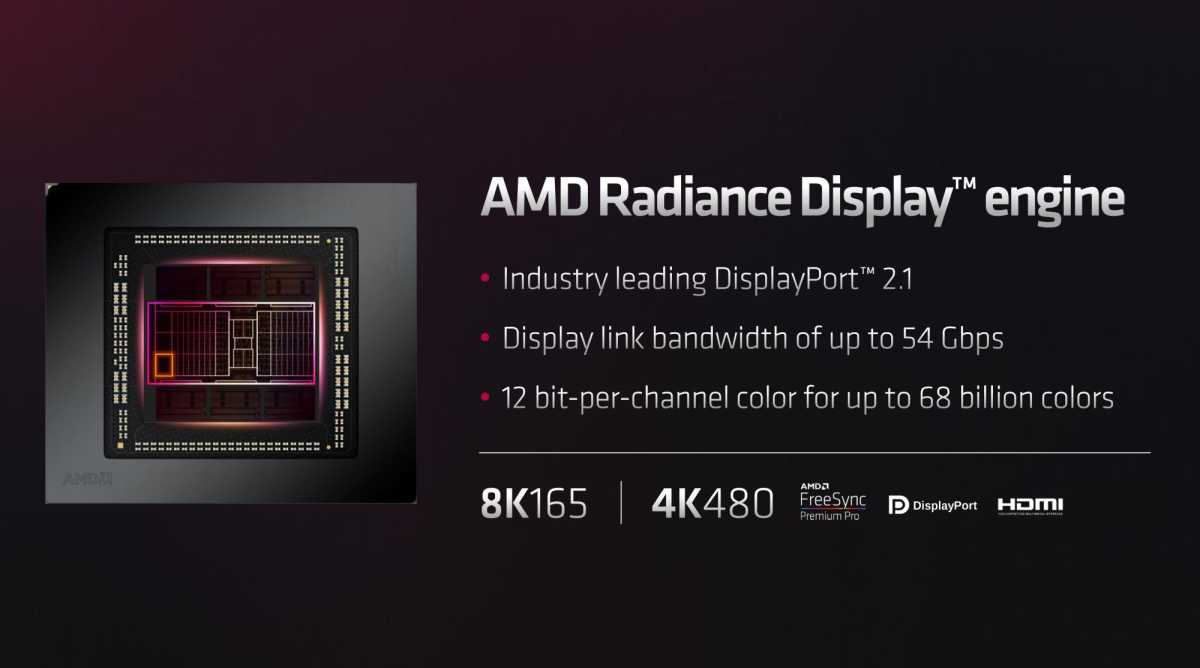
AMD
AMD
AMD
We’re not going to bog down this review with the full details, though. Our initial Radeon RX 7900 XTX reveal coverage has all the technical info you need if you want to wade in deeper. This review focuses on more practical matters.
That starts with the technical configuration details of the Radeon RX 7900 XTX and 7900 XT, and how they compare against last-generation’s Radeon RX 6900 XT flagship. As you can see, AMD crammed a lot, lot more of those more advanced CUs into these RDNA 3 chips:
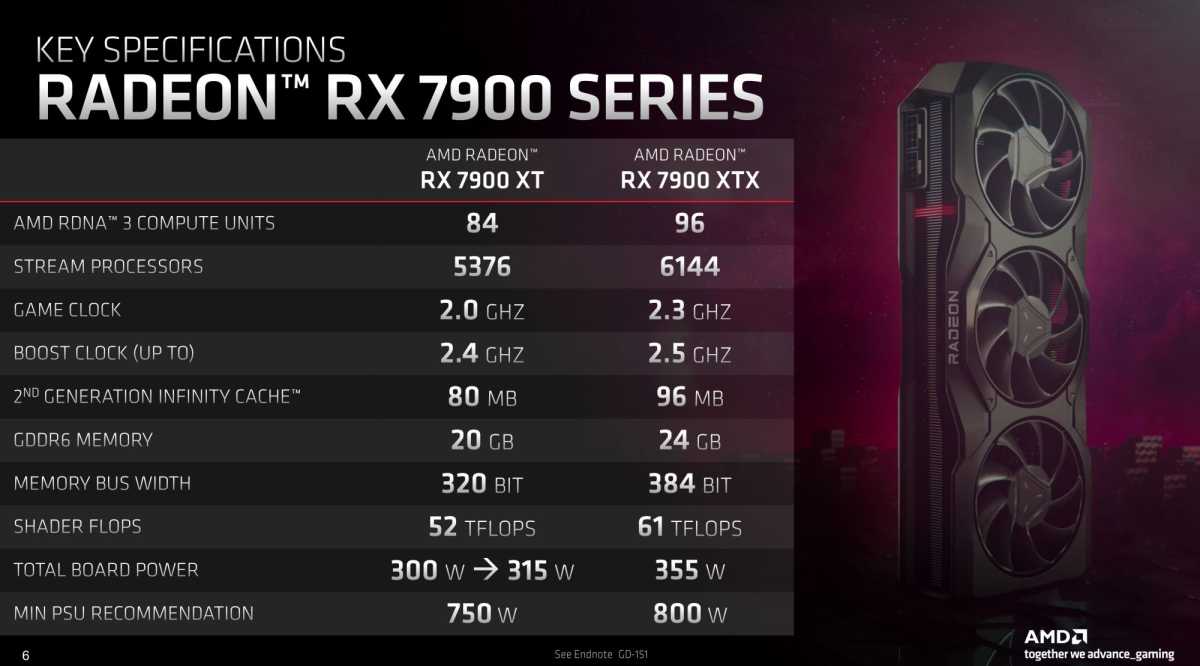
AMD
AMD
AMD
A couple other practical technical tidbits are worth calling out here. First, AMD learned its lessons from RDNA 2. While Infinity Cache works wonders for boosting performance in many games, at higher resolutions, you need ample VRAM and wide memory busses to tackle high-performance textures with grace. The Radeon RX 7900 XTX packs 24GB of GDDR6, while the 7900 XT offers 20GB, well above the 16GB found in the RTX 4080 and last-gen’s 6900 XT. It’s overkill but content creators will love it, and they’re paired with much wider 384-bit and 320-bit (respectively) buses than before. Between that and Infinity Cache, memory isn’t an issue with the 7900 series, full stop.
Also pay attention to the power draw of the flagship XTX model. While the $899 Radeon RX 7900 XT consumes a bit less power than its predecessor, the $999 7900 XTX cranks up the juice to compete with Nvidia’s latest and greatest. AMD recommends using an 800-watt power supply at minimum, and in our power testing benchmarks, we discovered that the XTX only draws a hair less power than the ferocious RTX 4090. Yes, this card is more efficient than prior GPU generations, but it’s still power-hungry.
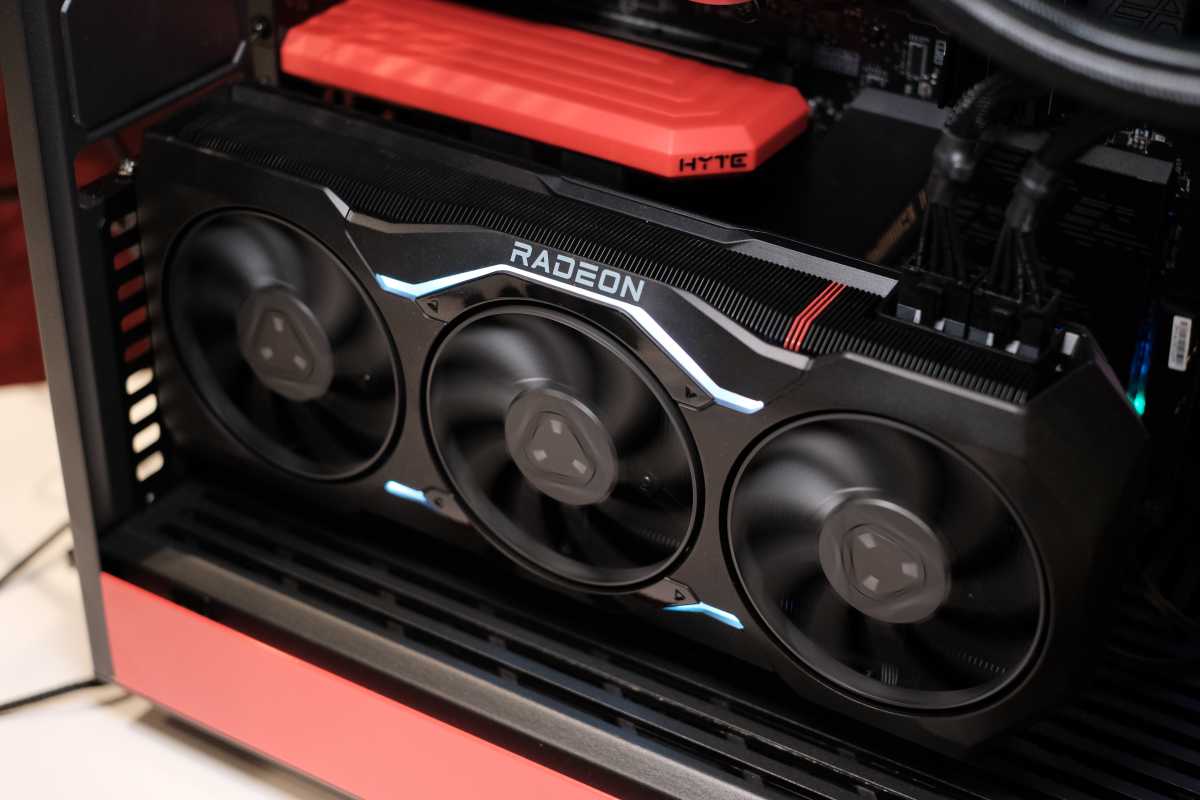
Adam Patrick Murray / IDG
Adam Patrick Murray / IDG
Adam Patrick Murray / IDG
….Which makes the relatively tiny size of AMD’s in-house GPUs all the more noteworthy. Nvidia and its partners slapped gargantuan 3- or 4-slot coolers on their 4080 and 4090 cards, powered by the melty new 12VHPWR connectors. Though custom RX 7900 boards also go big, AMD’s offerings stick to a modest 2.5-slot design that “fits in everything,” per small form factor PC guru Optimum Tech. That’s great for compatibility with existing PCs.
Also great: AMD’s Radeon RX 7900 series reference cards use just two traditional 8-pin power connectors. The cards sport dual DisplayPort 2.1 connections, a singular HDMI 2.1a port, and a USB-C connection compatible with DP 2.1 as well. Nvidia’s RTX 40-series lack USB-C, and most custom RX 7900 series cards we’ve seen so far swap it out for a standard DP 2.1 connection. So if that’s a key feature for you, AMD’s reference cards are the ones to target.
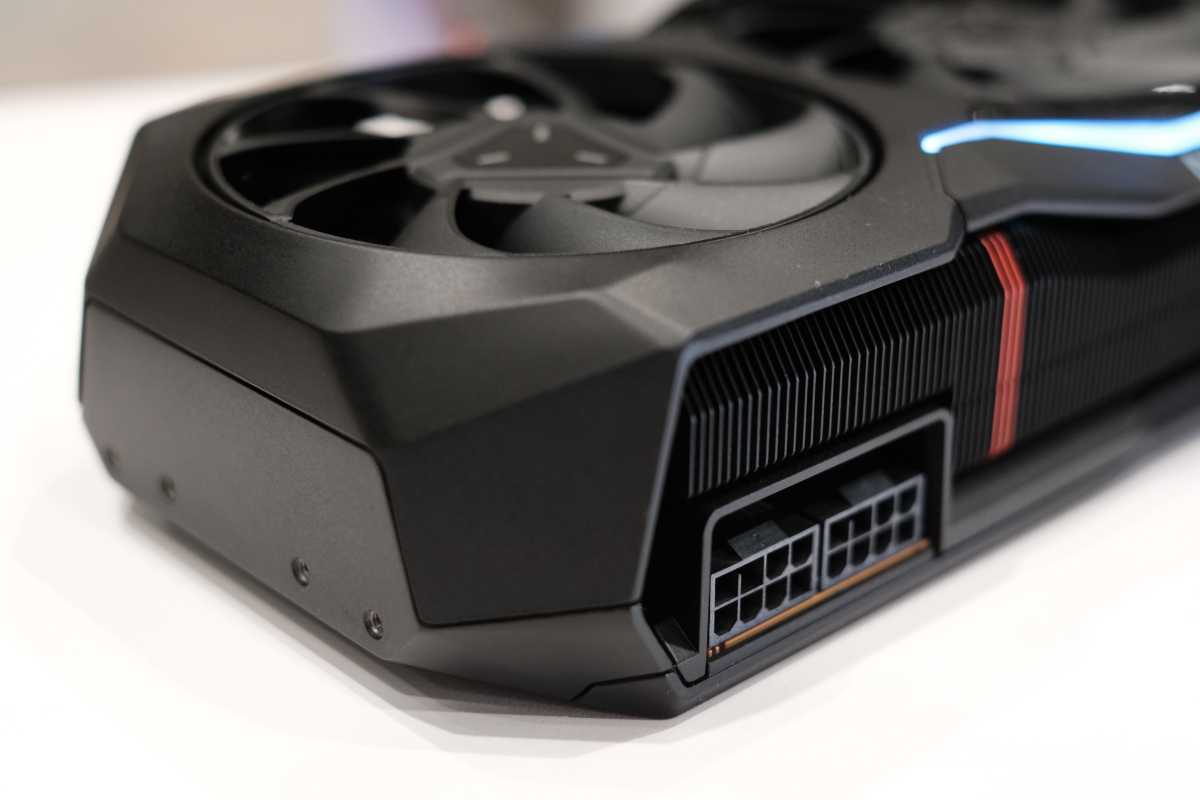
Adam Patrick Murray / IDG
Adam Patrick Murray / IDG
Adam Patrick Murray / IDG
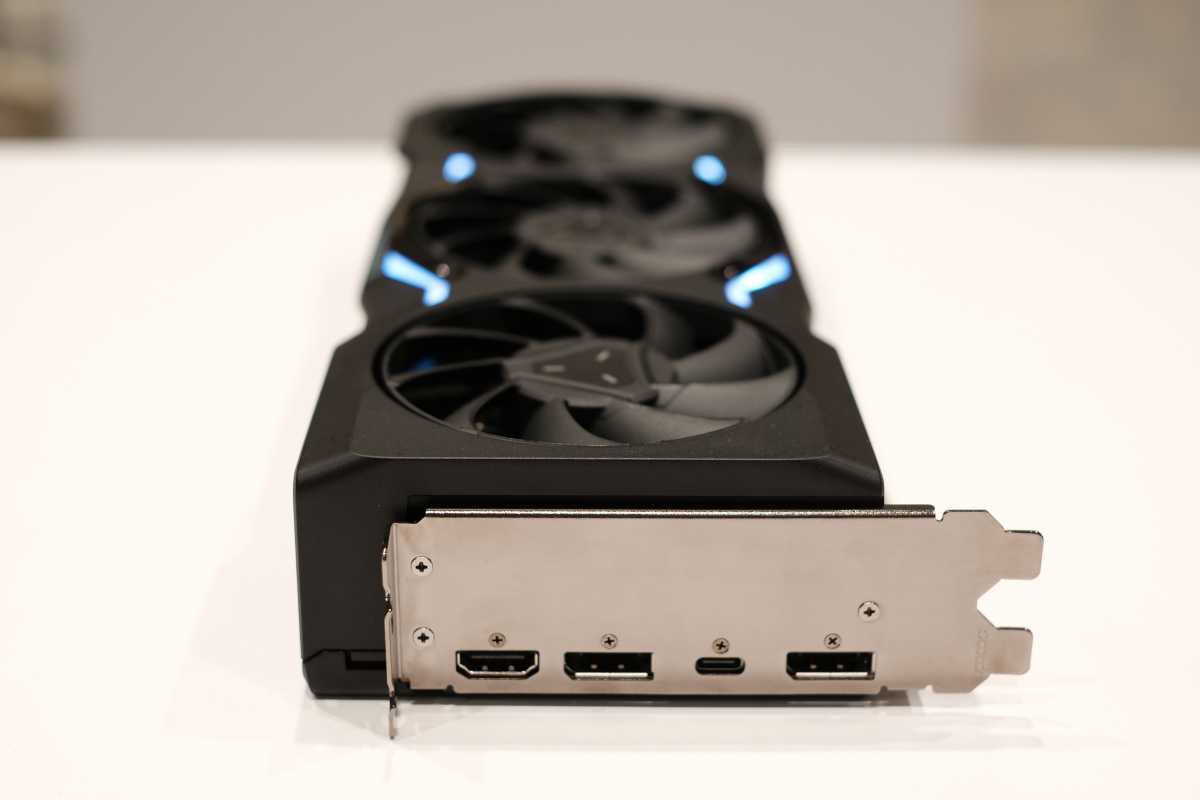
Adam Patrick Murray / IDG
Adam Patrick Murray / IDG
Adam Patrick Murray / IDG
For a deeper glimpse at these gorgeous GPUs, check out our separate close-up look at the Radeon RX 7900 XTX and XT.
Of course, these cards also support AMD’s abundant software features, some of which are only available when paired with an AMD Ryzen CPU. Those include FidelityFX Super Resolution 1.0 and 2.0 upscaling tech and its universal Radeon Super Resolution cousin, the performance-boosting Smart Access Memory, a new Smart Access Video feature for accelerating encoding tasks (which we hope to test soon), Radeon Anti-Lag for reduced latency, AMD Noise Suppression to eliminate background noise during video calls and streams, AMD Link to beam gameplay to other devices, Radeon Boost, power-saving Radeon Chill, Radeon Image Sharpening, AMD Privacy View, and more. They’re all great options to have at hand.
But enough talk. Let’s get to the benchmarks. Giddy-up.
Our test system
We evaluate graphics cards on an AMD Ryzen 5900X PC used exclusively for benchmarking GPUs. We now test with PCIe Resizable BAR (also known as Smart Access Memory on Ryzen systems) active, as most modern gaming PCs released in the last four years support the performance-boosting feature, either natively or via a motherboard firmware update. Nvidia also recommends turning on the optional “Hardware-accelerated GPU scheduling” option in Windows to let the RTX 40-series stretch its legs to the fullest, so we’ve made that tweak as well. Most of the hardware was provided by the manufacturers, but we purchased the storage ourselves.
AMD Ryzen 5900X, stock settingsAMD Wraith Max coolerMSI Godlike X570 motherboard32GB G.Skill Trident Z Neo DDR4 3800 memory, XMP activeCorsair HX1500i power supply (and optional $20 12VHPWR 600 cable for Nvidia GPUs)1TB SK Hynix Gold S31 SSD x2
We’re comparing AMD’s Radeon RX 7900 series against the $1,200 Nvidia GeForce RTX 4080 and $1,600 RTX 4090, their natural next-gen rivals. We’ve also included benchmarks from the last-gen Radeon RX 6900 XT, as well as Nvidia’s RTX 3080, 3080 Ti, and 3090, to show generational improvements. All of these cards remain solid 4K offerings, even the last-gen models.
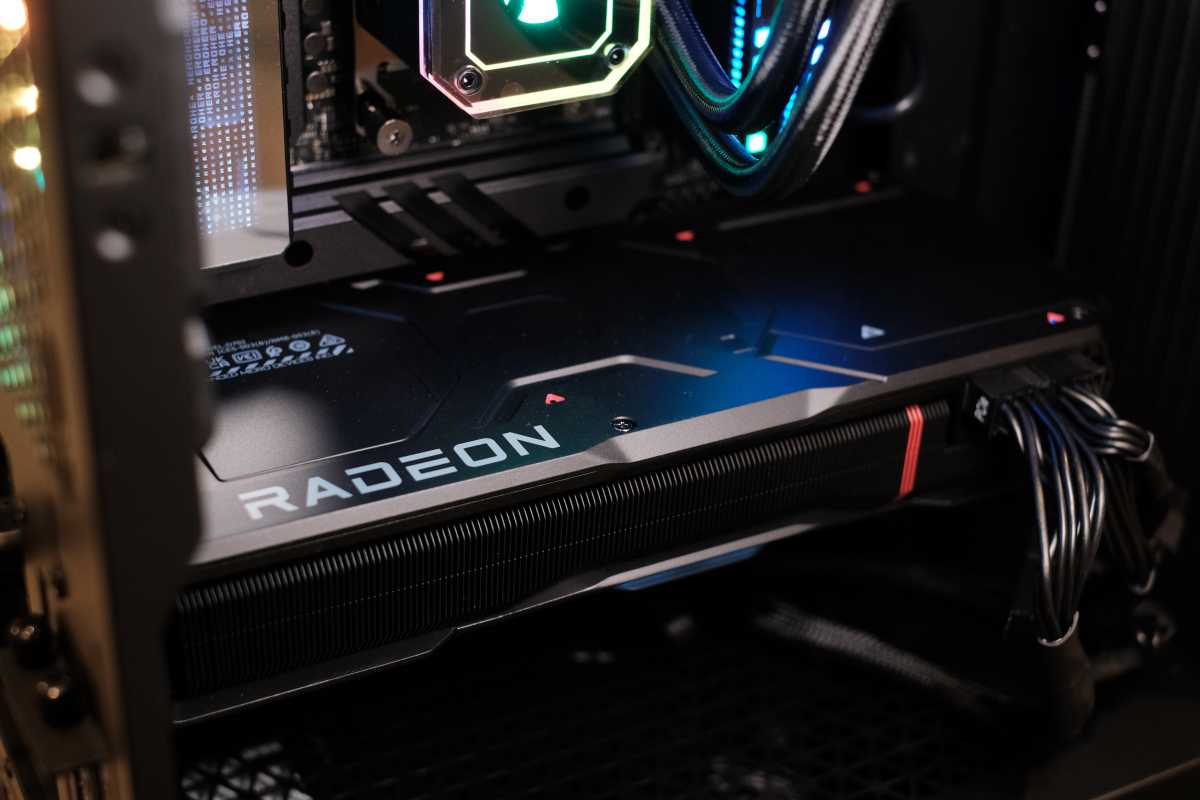
Adam Patrick Murray / IDG
Adam Patrick Murray / IDG
Adam Patrick Murray / IDG
We’ve also updated the games in our testing suite for this new generation. Our lineup of games spans various engines, genres, vendor sponsorships (Nvidia, AMD, and Intel), and graphics APIs (DirectX 9, 11, DX12, and Vulkan), in an effort to represent a full range of performance potential. Each title is run using its in-game benchmark, sanity checked by Nvidia’s FrameView tool, at the highest possible graphics presets unless otherwise noted, with VSync, frame rate caps, real-time ray tracing or DLSS effects, and FreeSync/G-Sync disabled, along with any other vendor-specific technologies like FidelityFX tools or Nvidia Reflex. We’ve also enabled temporal anti-aliasing (TAA) to push these cards to their limits.
Each benchmark gets run at least three times, with the average result for each test listed as the final result. Outside of esports, we’ve limited our benchmarks to 4K and 1440p resolutions, as those are the natural fits for these bruising GPUs. Most cost four figures or more at launch. Pay close attention to how the 7900 XTX and RTX 4090 trade blows at both resolutions—in most cases, AMD’s card is faster at 1440p resolution than the Nvidia card that costs $600 more (thanks Infinity Cache!), while 4K performance varies wildly. Sometimes the 7900 duo struggles to surpass the RTX 4080, while other times it can meet (and, rarely, beat) even the 4090.
Gaming performance benchmarks
Esports and older APIs
Let’s kick things off with a pair of ultra-popular esports games, and a tactical strategy game running on DX11.
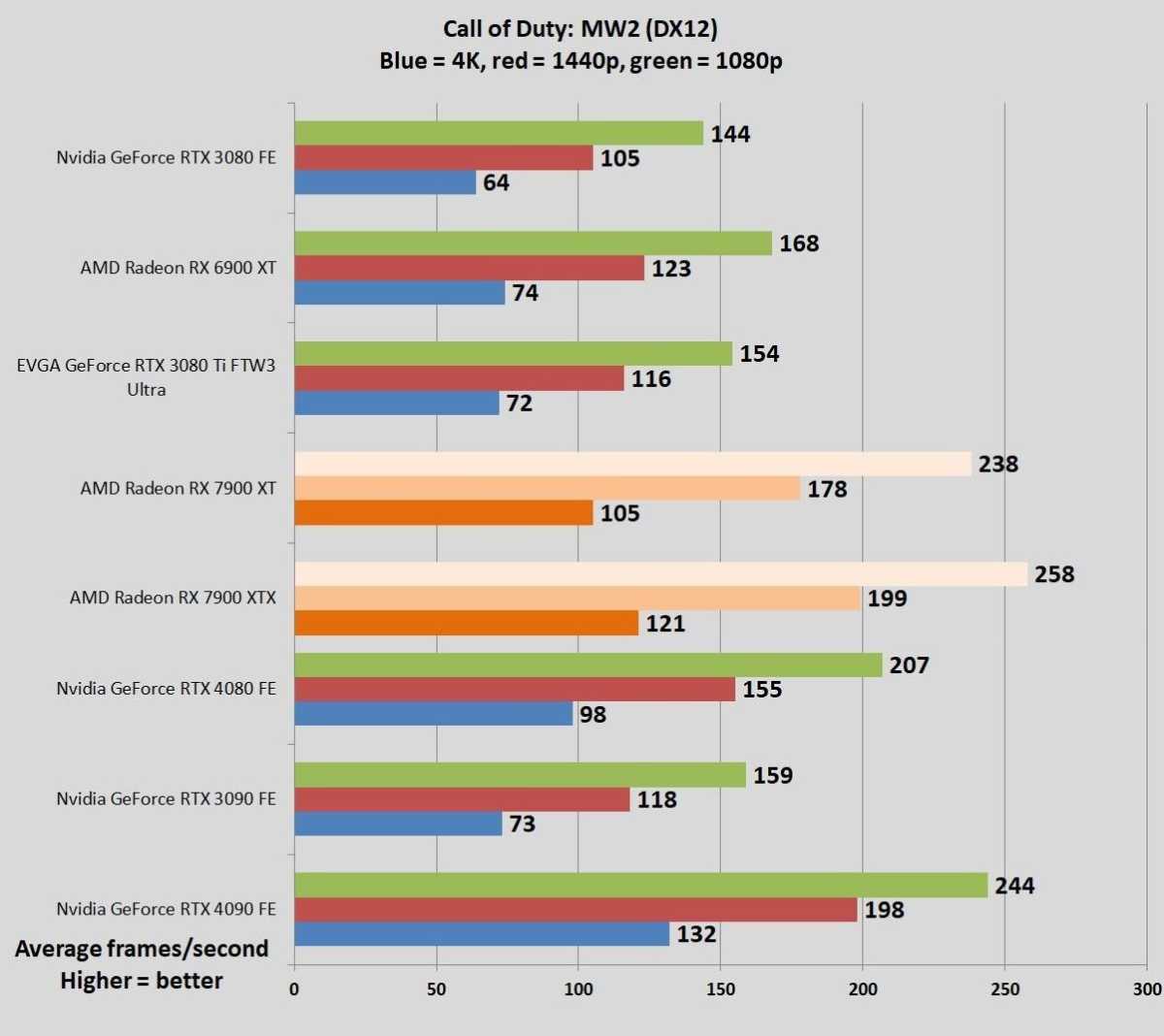
Brad Chacos/IDG
Brad Chacos/IDG
Brad Chacos/IDG
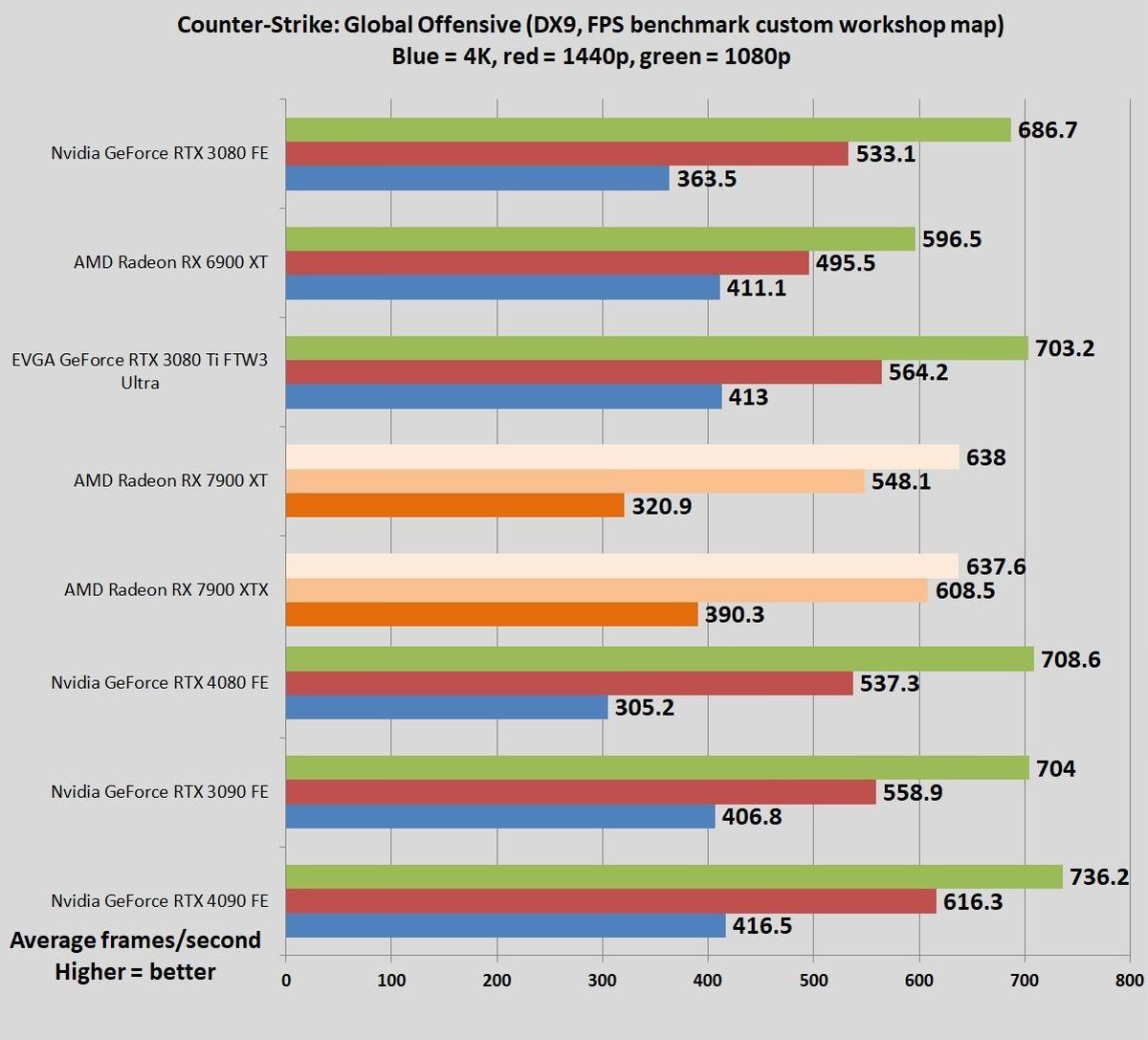
Brad Chacos/IDG
Brad Chacos/IDG
Brad Chacos/IDG

Brad Chacos/IDG
Brad Chacos/IDG
Brad Chacos/IDG
It’s a killer start for RDNA 3. In Call of Duty: Modern Warfare 2, the Radeon RX 7900 series mops the floor with the 4080 at all resolutions, with the XTX tying or surpassing the 4090. Things get a bit more complicated in the ever-popular CSGO, where Nvidia’s Ada Lovelace architecture flexes a bit more, delivering unrivaled 1080p performance. The $899 7900 XT manages to slightly trump the $1,200 RTX 4080 at all other resolutions, however, while the XTX beats the 4090 at 1440p, but gets edged at 1080p and whomped at 4K. These are all fantastically fast cards for CSGO though—even the last-gen models.
AMD’s new GPUs are clearly favored in the DX11-powered Total War Troy on the other hand, with the XT breezing ahead of the 4080 and the XTX taking the vaunted 4090 down completely.
DX12 and Vulkan
With that out of the way, let’s turn to the more modern DX12 and Vulkan graphics APIs being used in many (most?) triple-A games these days. Once again, pay close attention to how the various Radeon RX 7900 series and RTX 40-series GPUs stack up against each other, at both resolutions. We won’t dive into a play-by-play for all of these games, but performance can vary greatly depending on the game and resolution. Peep those Gears Tactics results for an extreme example.
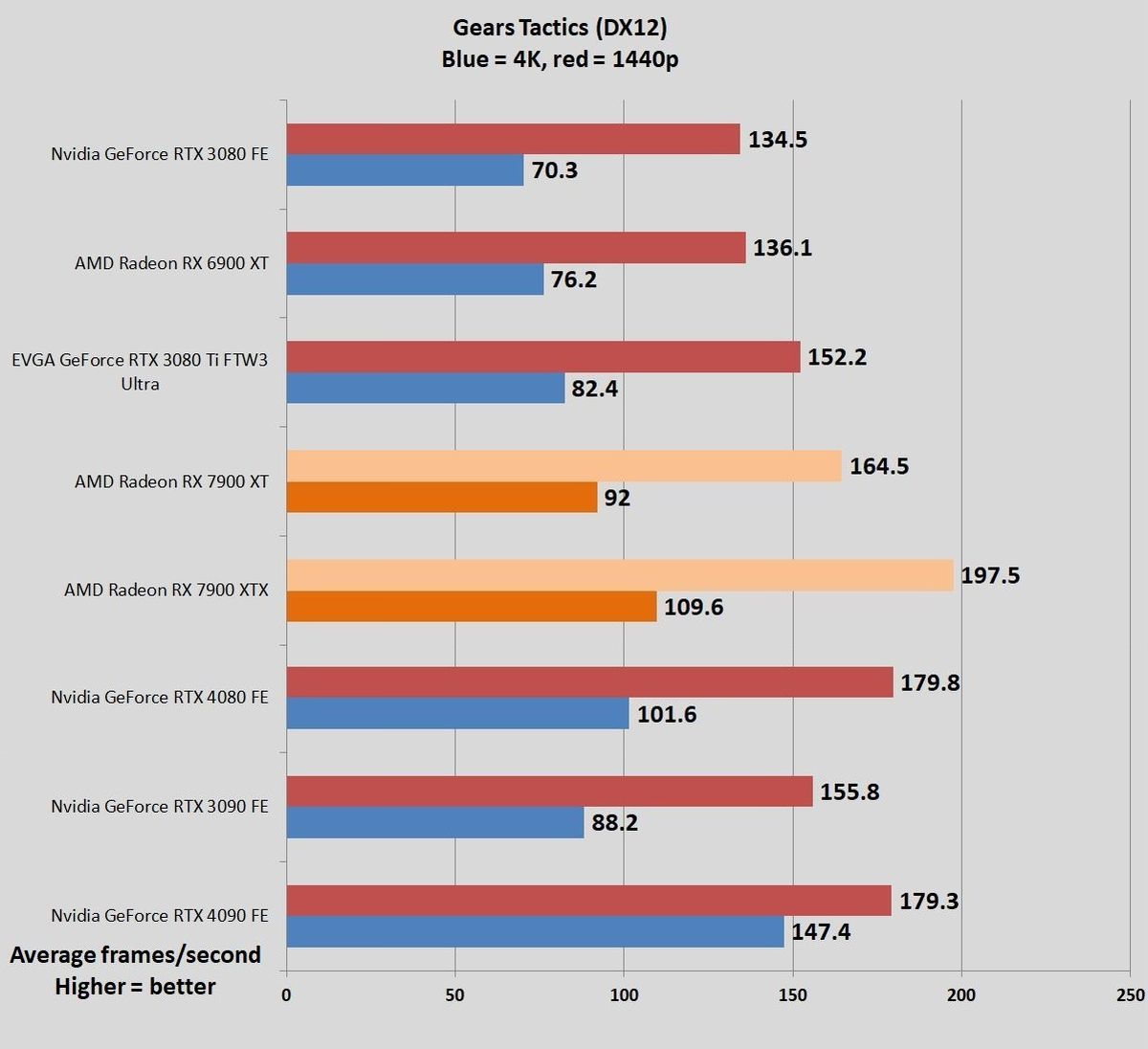
Brad Chacos/IDG
Brad Chacos/IDG
Brad Chacos/IDG

Brad Chacos/IDG
Brad Chacos/IDG
Brad Chacos/IDG
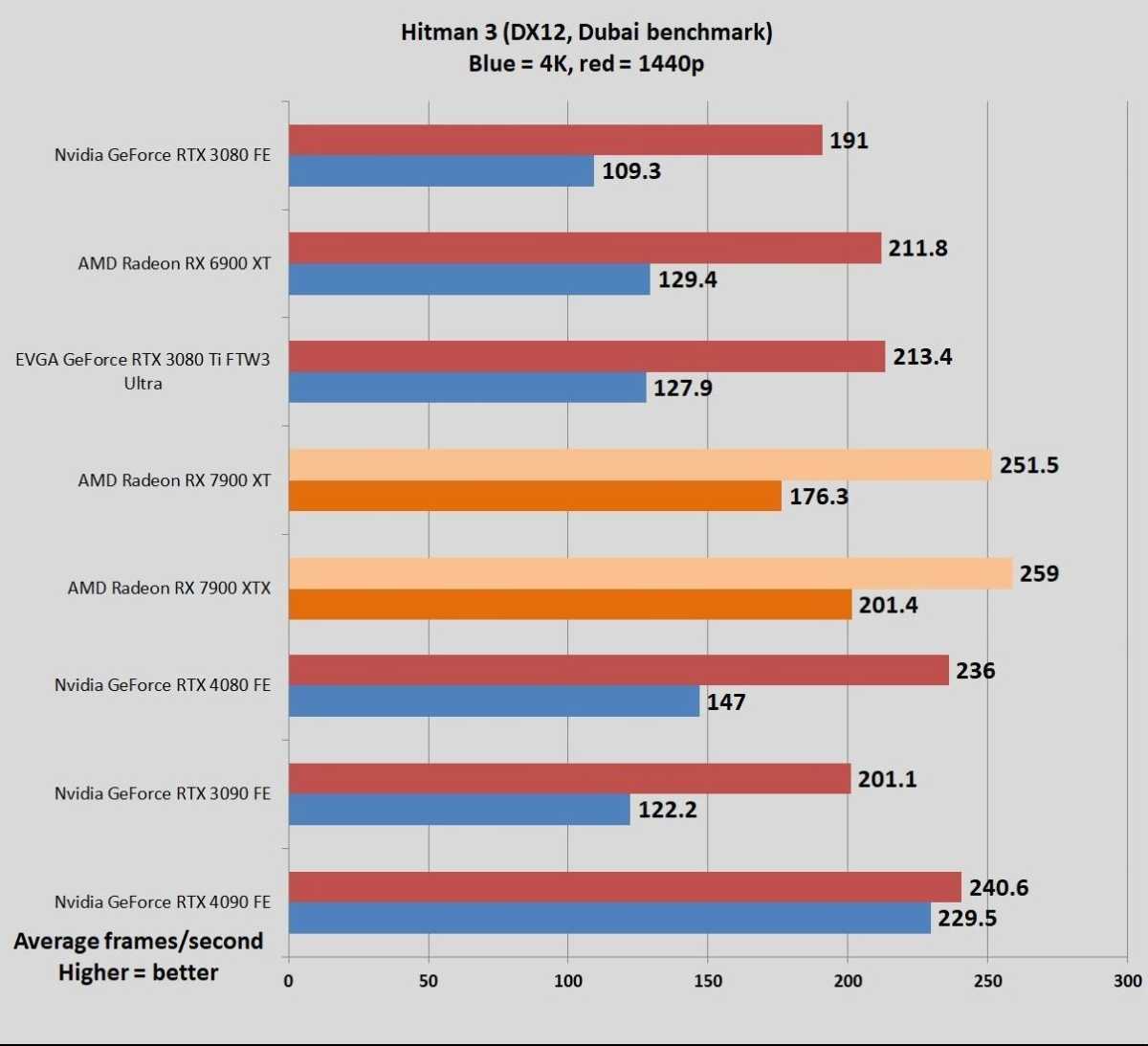
Brad Chacos/IDG
Brad Chacos/IDG
Brad Chacos/IDG
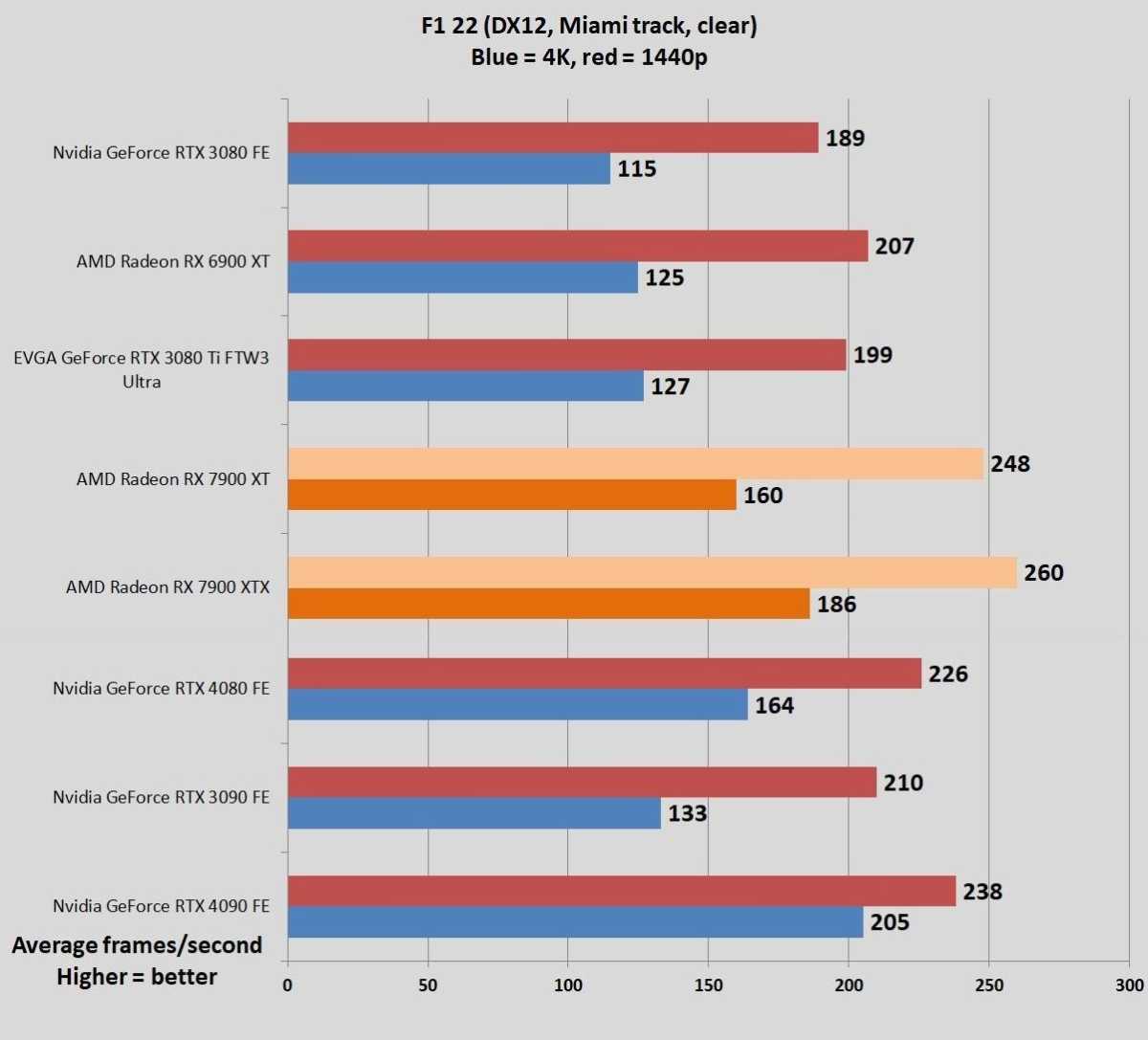
Brad Chacos/IDG
Brad Chacos/IDG
Brad Chacos/IDG
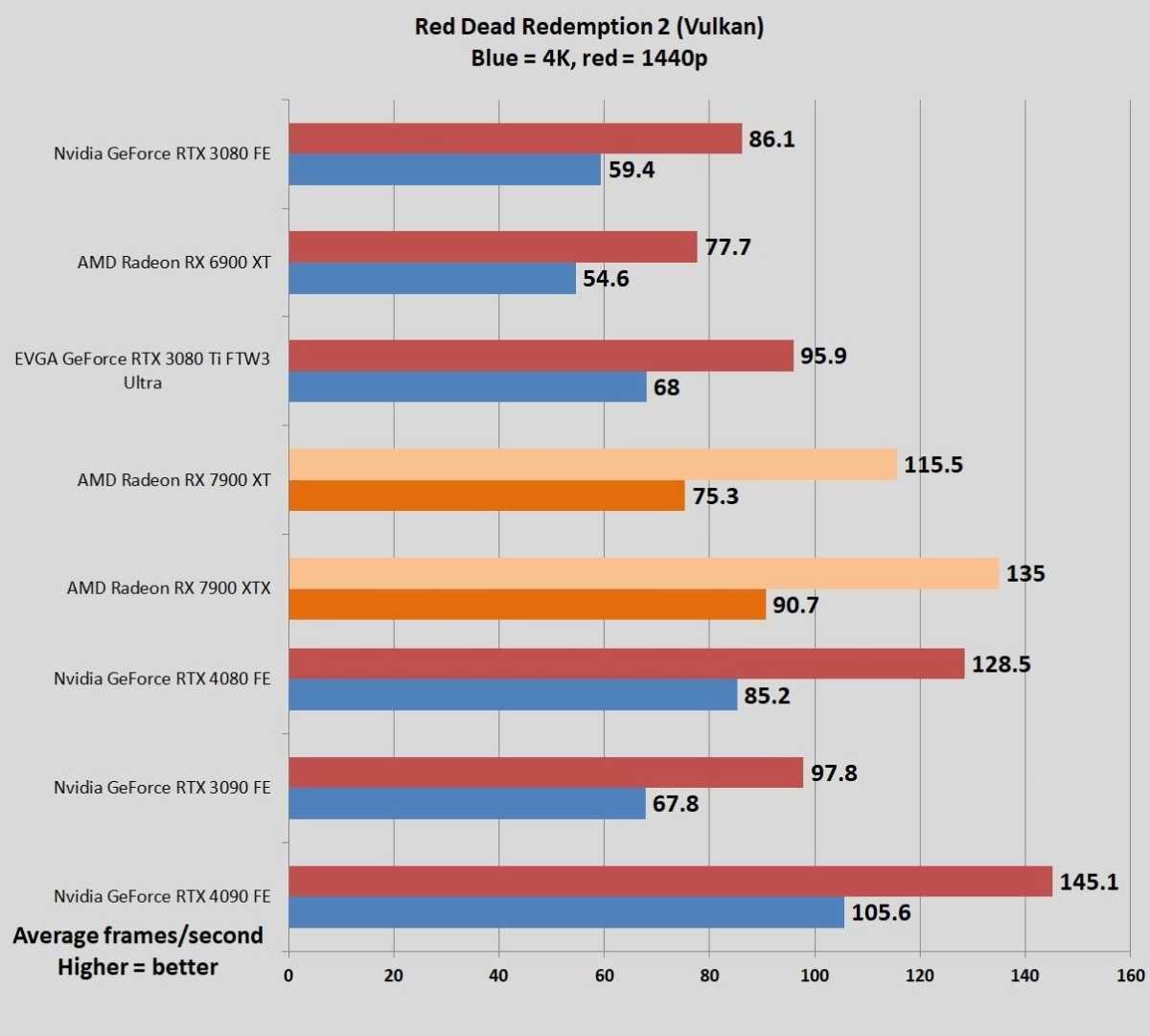
Brad Chacos/IDG
Brad Chacos/IDG
Brad Chacos/IDG
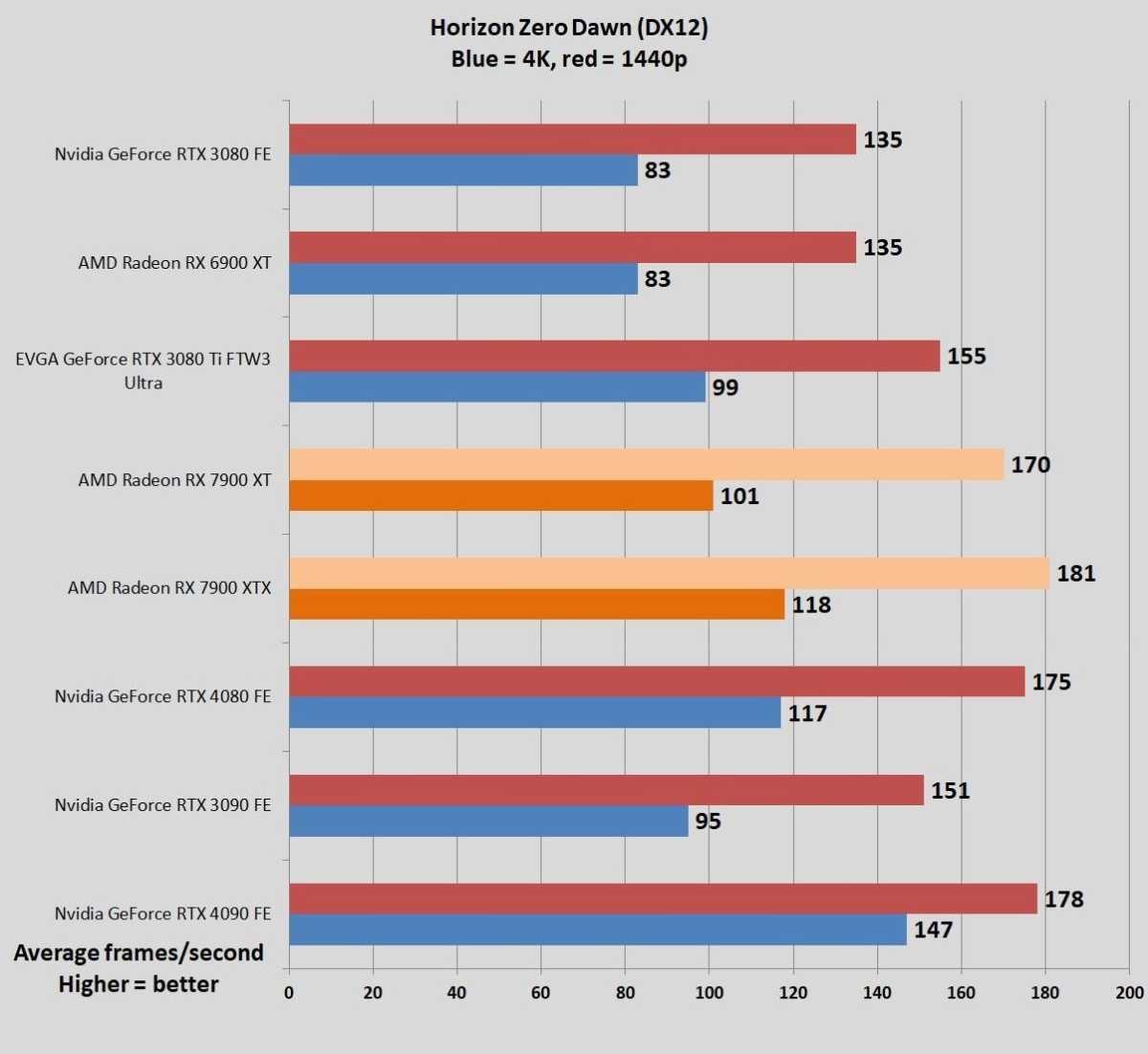
Brad Chacos/IDG
Brad Chacos/IDG
Brad Chacos/IDG
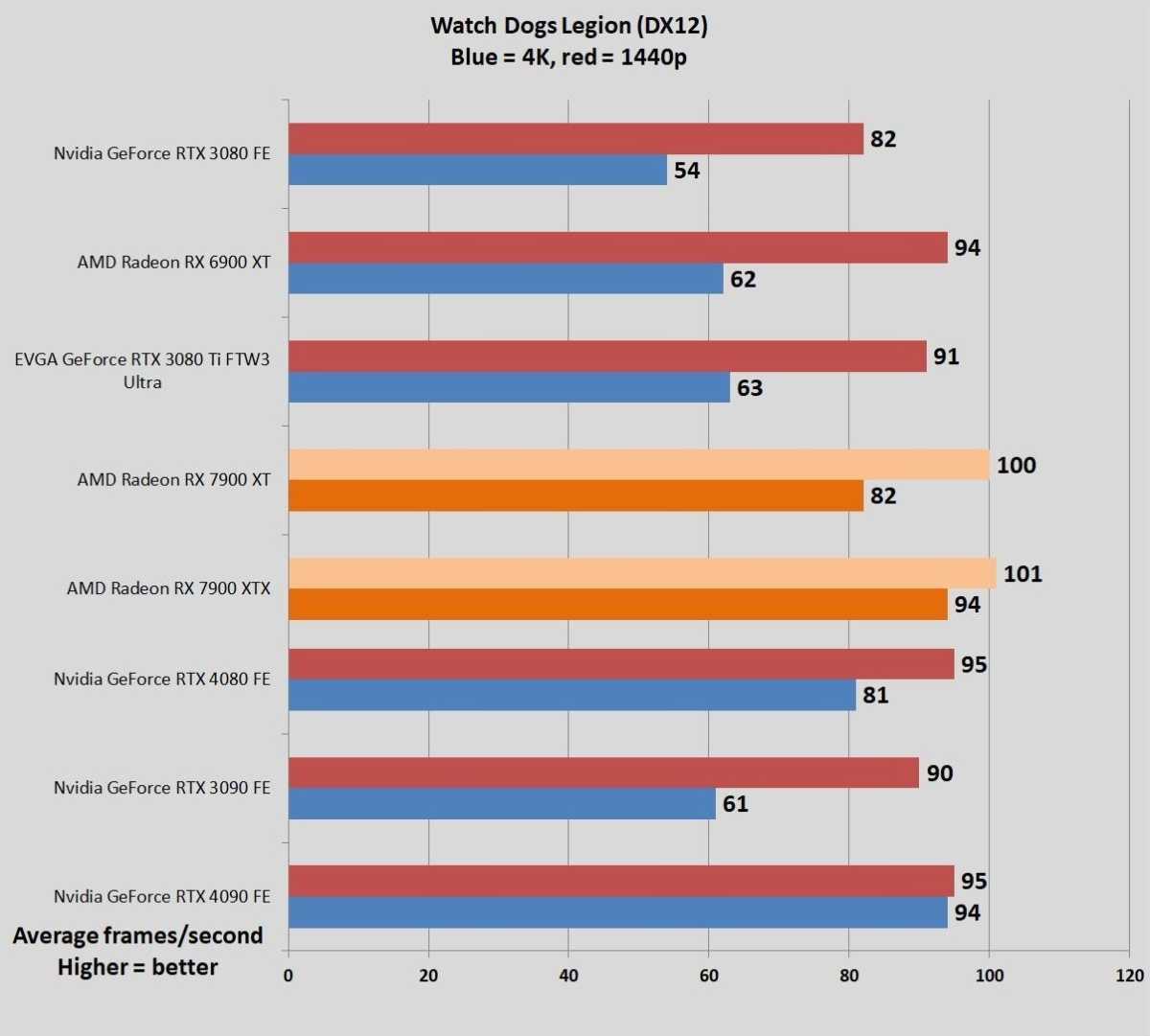
Brad Chacos/IDG
Brad Chacos/IDG
Brad Chacos/IDG
Taking the most wild game-to-game fluctuations out of the picture, in general, AMD’s GPUs tend to have an advantage at 1440p, while Nvidia’s still own 4K—but that’s not a universal truth.
Skittering bugs
Now for a mild awkward note: We encountered several bugs during our testing. None proved severe or pervasive, aside from Red Dead Redemption 2 constantly crashing at 1440p resolution with FSR 2 enabled, but we don’t usually bump into oddities quite so regularly during reviews. That said, they tend to be more common at the introduction of a new GPU architecture (like RDNA 3) and usually get mopped up quickly, and we’ve already made AMD aware of these issues. The bugs we encountered are:
Red Dead Redemption 2 benchmark consistently crashes with FSR 2 Balanced at 1440p resolution. This affects prior-gen Radeon GPUs as well. AMD says a fix is being investigated, but to use the FSR Quality preset as a workaround in the meantime.Hitman 3 benchmark crashes sporadically at the same 1440p, FSR 2 Balanced settings, but only sometimes, and only on the Radeon RX 7900 XTX.In one Call of Duty: Modern Warfare 2 benchmark run out of 15 with the $899 7900 XT, something glitched and all the buildings rendered in neon rainbow for some reason—pretty trippy and cool, but not ideal. Fortunately, it didn’t resurface again in any other runs, or in several hours of playing COD multiplayer with the more powerful XTX.

Brad Chacos/IDG
Brad Chacos/IDG
Brad Chacos/IDG
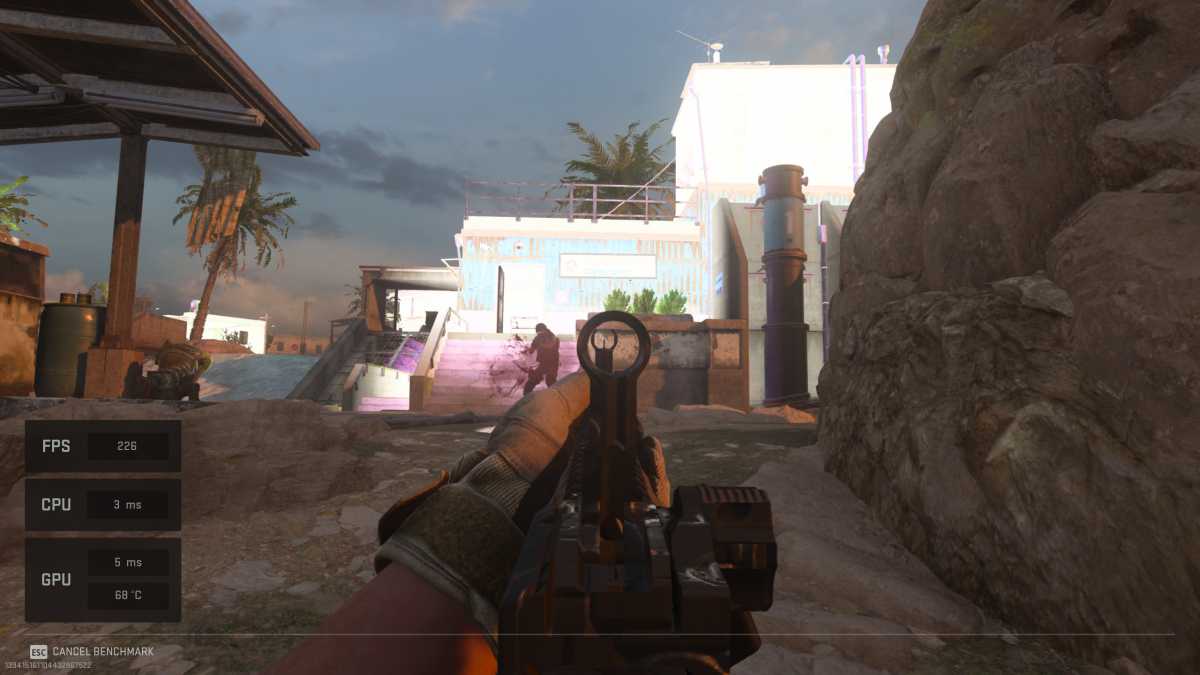
Brad Chacos/IDG
Brad Chacos/IDG
Brad Chacos/IDG
Twice, games refused to recognize the 7900 XT, reverting to a “Windows DirectX Render Device” instead and drastically reducing performance. Running DDU and reinstalling the drivers fixed the issues both times, but I’ve never seen that before.
Bottom line? You might run into infrequent bugs during the early days of the new Radeon RX 7900 series, especially if you’re using FSR 2.1 Balanced to increase 1440p gaming performance. None were true showstoppers, however. While bugs are always irritating, I don’t feel these minor, sporadic ones diminish the 7900 XTX and XT’s overall appeal, especially with AMD already working to squash them.
Radeon RX 7900 XTX and XT ray tracing benchmarks
We also need to dig into the Radeon RX 7900-series’ raw ray tracing performance. AMD substantially overhauled how RDNA 3 handles ray tracing, enhancing not only the raw performance of its RT accelerators, but also adding a pair of dedicated AI accelerators per CU for the first time. Those AI accelerators aren’t doing much now, but you have to think they’ll be a big part of the next-gen FSR 3.0 already teased to launch in 2023. Read our initial Radeon RX 7900 series coverage for a deeper dive into the architectural changes AMD made with RDNA 3.

AMD
AMD
AMD
Want a pre-benchmark TL;DR? AMD made huge strides here, with the Radeon RX 7900 XTX meeting the last-gen RTX 3090’s ray tracing performance levels—a.k.a. the best ever until a couple months ago. Ray tracing is no longer a weakness for AMD, though it remains a clear Nvidia strength. That makes sense, as Nvidia is a generation ahead, having introduced RT and AI hardware in the RTX 20-series years ago. It’s worth noting that AMD’s FSR upscaling technology is seeing a rapid uptick in adoption now that it’s established. At the RTX 4090’s launch, most of the ray-traced games in our testing suite supported Nvidia’s DLSS, but not any iteration of FSR. Now, only Watch Dogs Legion lacks it (which is why AMD’s cards show a 0 score there). Huzzah to more options that cover more gamers!
The charts below show the raw performance of the tested GPUs in the selected games with ray tracing off, to get a baseline. Next, we show performance with all available ray tracing effects active and set to Ultra. The important thing to note here is how these ray-traced frame rates compare proportionally to the game running with RT off, which reveals how efficient each GPU’s raw ray tracing capabilities are. (If a game runs at 100fps with ray tracing off, and two different GPUs run the game with ray tracing on at 50fps and 25fps, for example, the former GPU offers better raw ray tracing chops.)
Finally, since these cutting-edge lighting effects send frame rates plummeting, pairing ray tracing with some sort of image upscaling technology (like Nvidia’s DLSS, AMD’s FSR 2, and Intel’s XeSS) is often a necessity. We’ve also included performance metrics with DLSS or FSR running in balanced mode to show the sort of full-stack ray tracing performance you’ll see in the real world. Running FSR/DLSS in Performance or Ultra Performance mode would result in even higher frame rates, but with potentially more image oddities. We like the balance of speed and fidelity that DLSS Balanced provides.
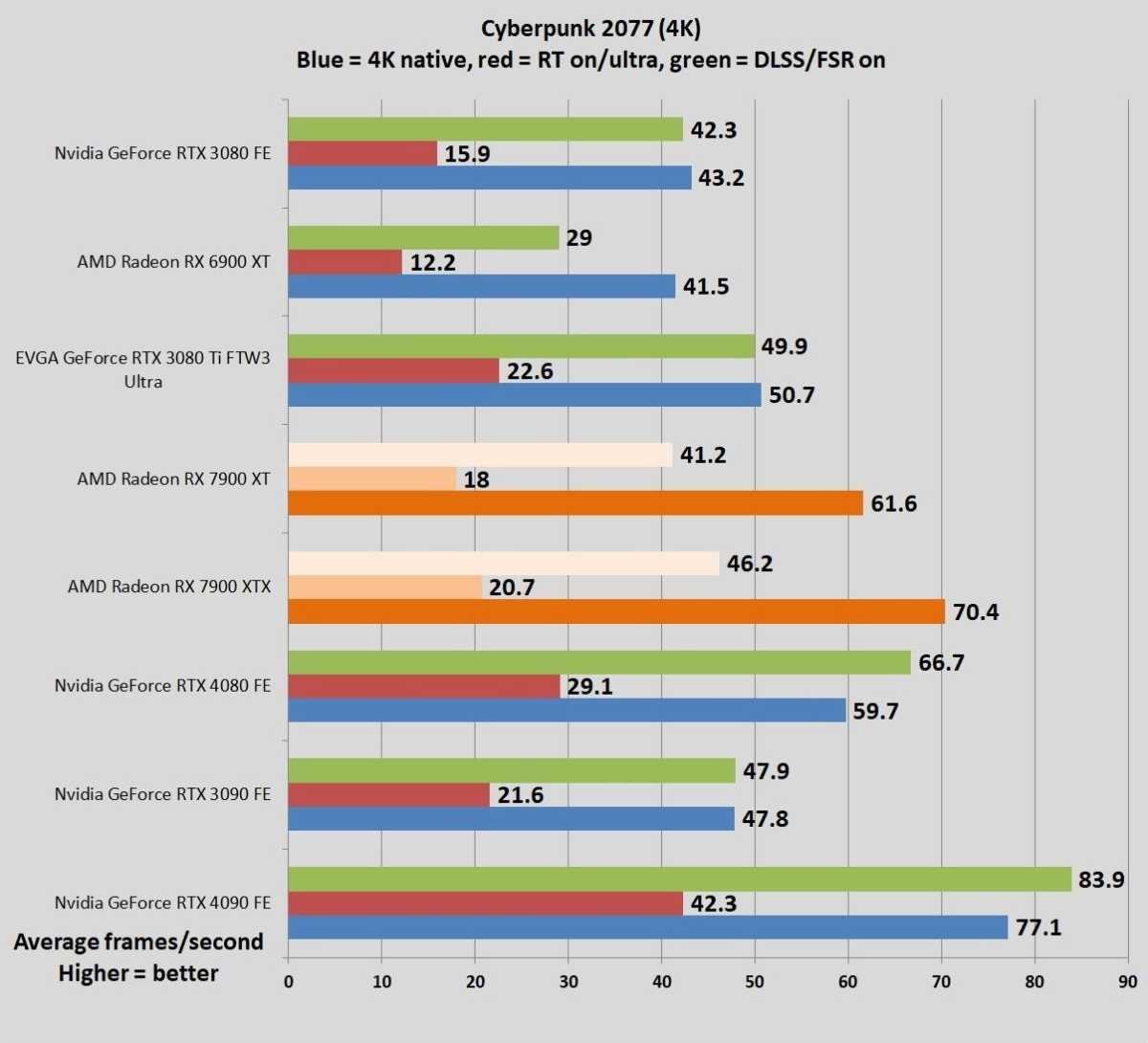
Brad Chacos/IDG
Brad Chacos/IDG
Brad Chacos/IDG
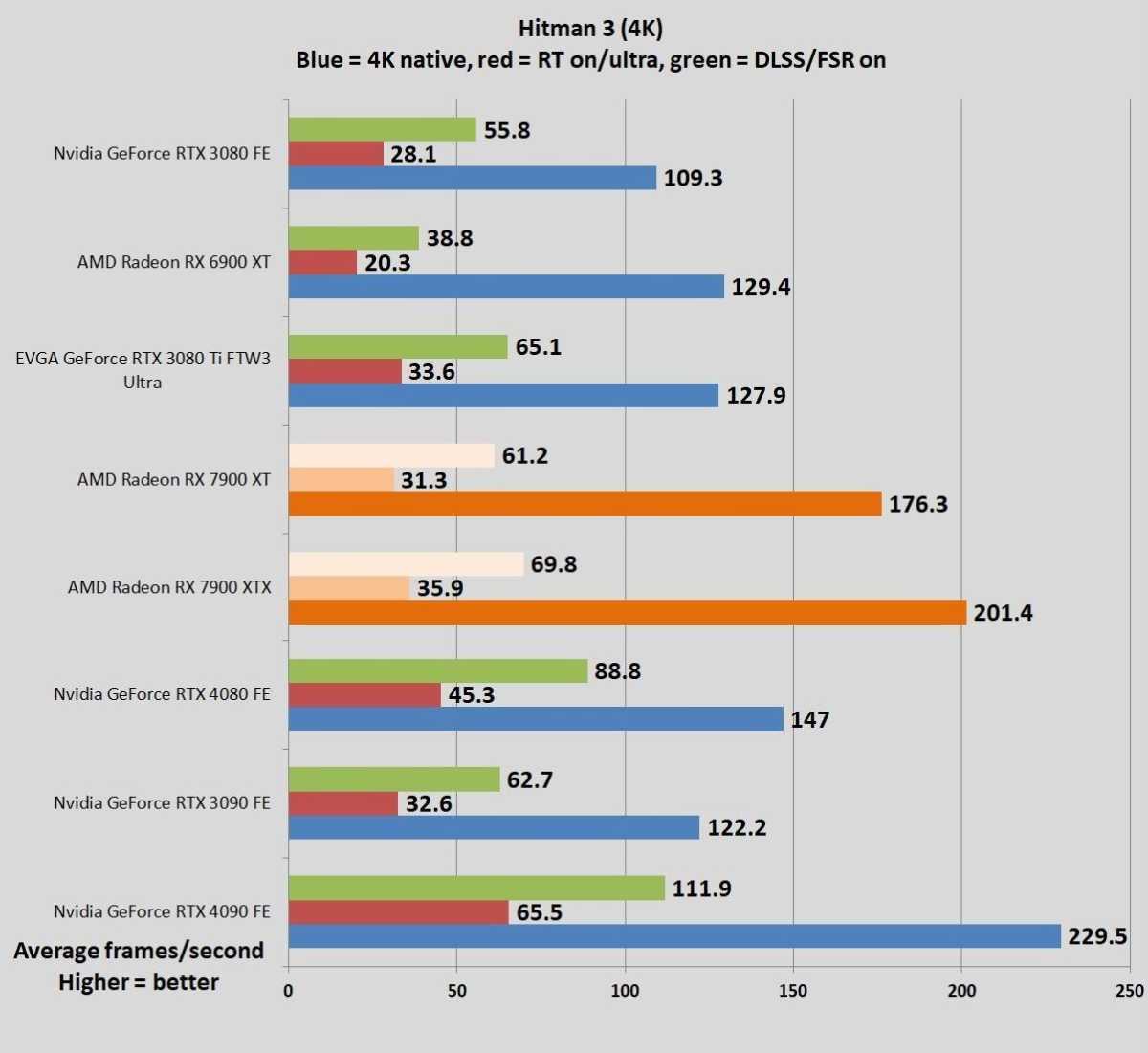
Brad Chacos/IDG
Brad Chacos/IDG
Brad Chacos/IDG
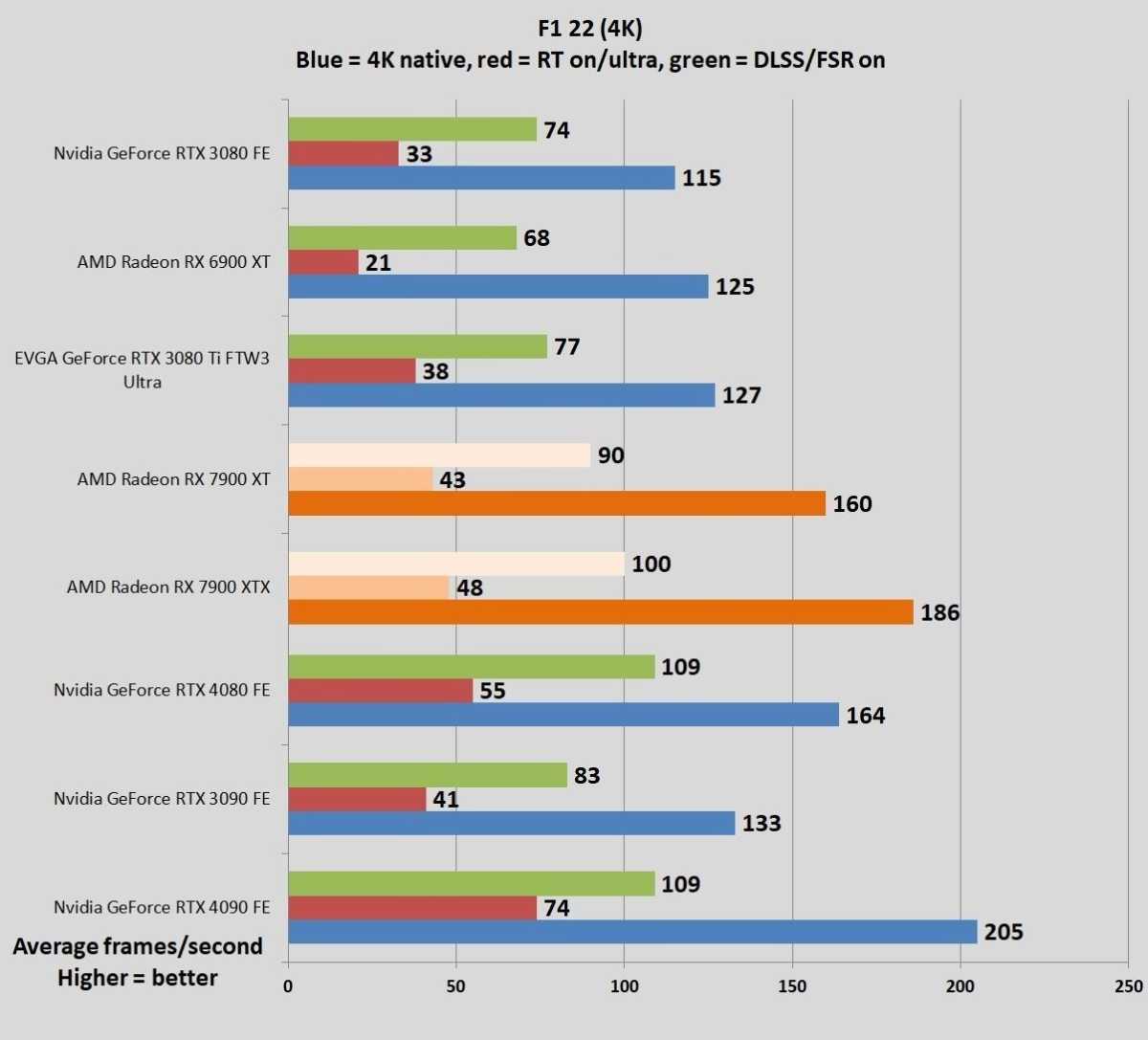
Brad Chacos/IDG
Brad Chacos/IDG
Brad Chacos/IDG

Brad Chacos/IDG
Brad Chacos/IDG
Brad Chacos/IDG
We’ve also included a chart below showing Red Dead Redemption 2 4K performance with FSR 2/DLSS Balanced on the various GPUs. That game lacks ray tracing, but it’s graphically intense, and these results can show us the sort of speed boosts we can expect using the upscaling technologies on newer cards versus older ones. (One caveat: As mentioned in the Bugs section, RDR2 currently crashes on all AMD GPUs when trying to run at 1440p with FSR Balanced mode enabled. Use Quality mode instead for now at that resolution.)
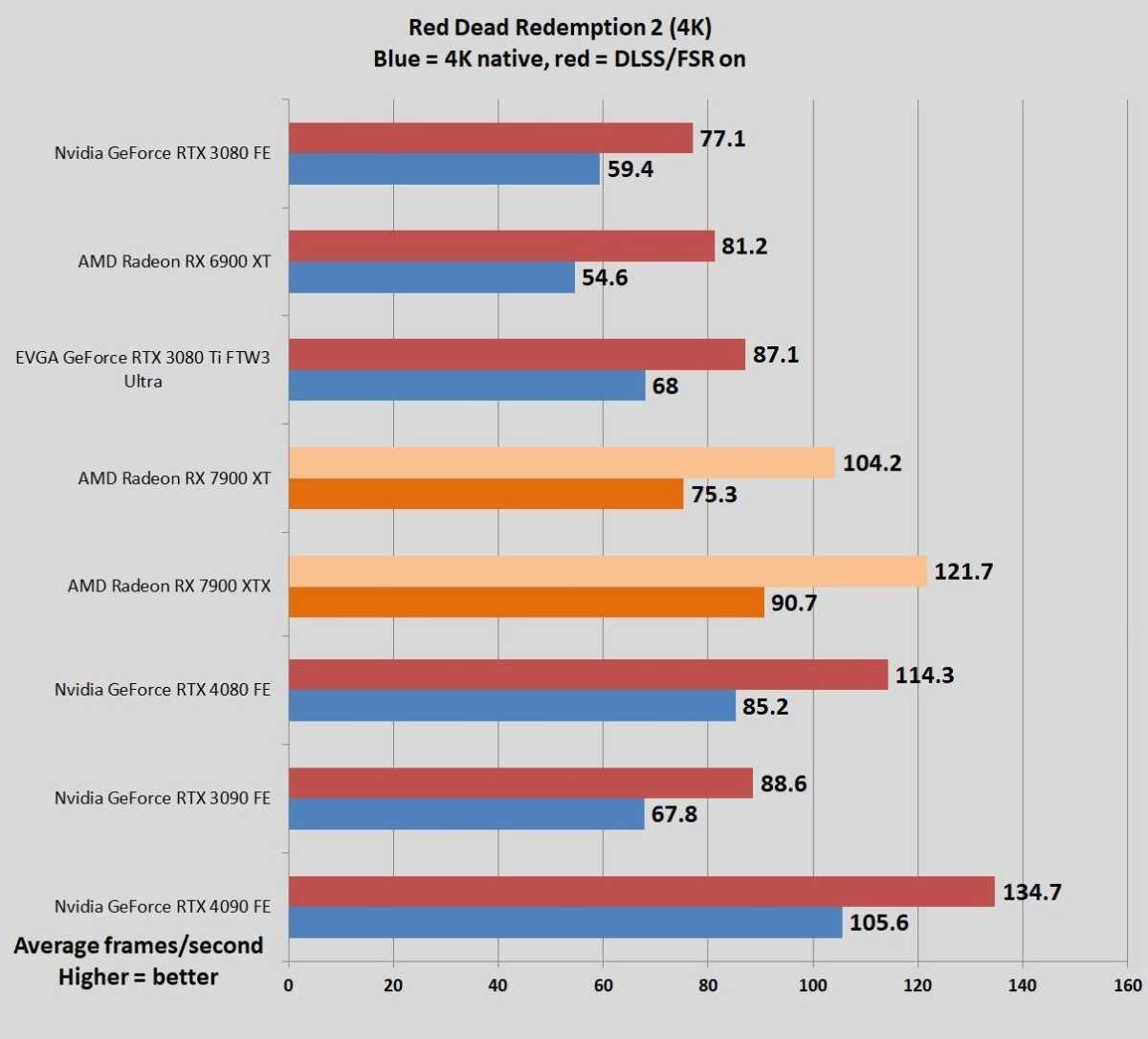
Brad Chacos/IDG
Brad Chacos/IDG
Brad Chacos/IDG
Across the board, RTX 40-series GPUs get about 30 more frames per second with DLSS Balanced, on, while older RTX 30-series GPUs get 20fps—clearly showing improved efficiency in Nvidia’s latest generation of dedicated AI tensor cores, which power DLSS. AMD’s FSR 2 runs on standard GPU shaders rather than requiring specialized hardware and boosts frame rates by about 30fps on the 7900 duo and the older Radeon RX 6900 XT alike.
All of these upscaling technologies look great in practice, though F1 22’s use of the much simpler FSR 1.0 upscaling results in a more shimmering picture at 1440p resolution. It’ll be adding FSR 2.0 soon however. One thing Radeon GPUs won’t be getting? DLSS 3 Frame Generation, a stunning technical achievement that’s already a real weapon in Nvidia’s arsenal despite being in its early days. AMD has no answer for it and it can be a huge boon if you’re trying to fuel a high-refresh rate 4K monitor.
Power and thermals
We test power draw by looping the F1 22 benchmark at 4K for about 20 minutes after we’ve benchmarked everything else (to warm up the GPU) and noting the highest reading on our Watts Up Pro meter, which measures the power consumption of our entire test system. The initial part of the race, where all competing cars are onscreen simultaneously, tends to be the most demanding portion.
This isn’t a worst-case test; this is a GPU-bound game running at a GPU-bound resolution to gauge performance when the graphics card is sweating hard. If you’re playing a game that also hammers the CPU, you could see higher overall system power draws. Consider yourself warned.
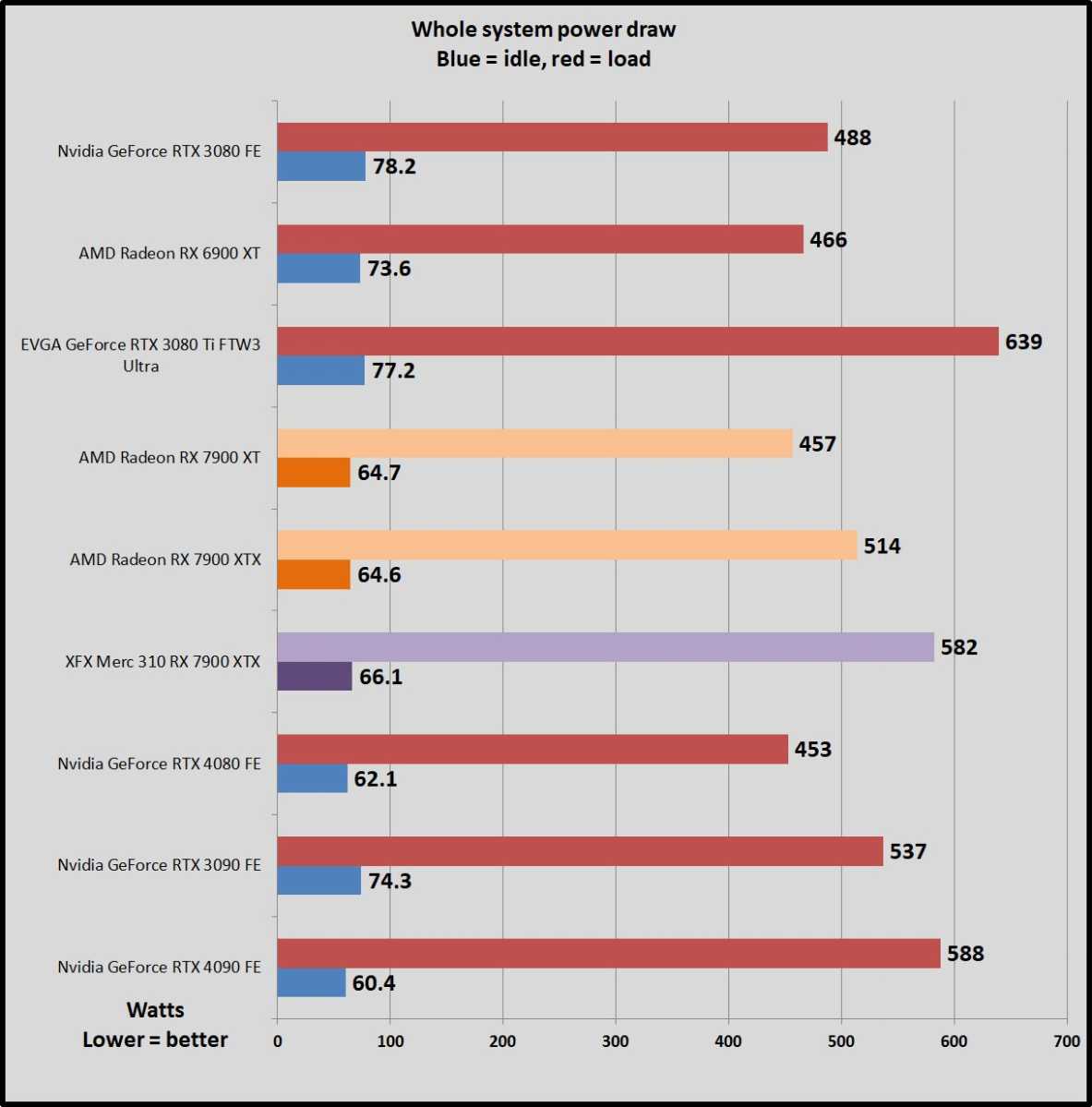
Brad Chacos/IDG
Brad Chacos/IDG
Brad Chacos/IDG
Well well well, isn’t this a surprise. AMD has been touting the efficiency gains in RDNA 3 and smack-talking Nvidia’s move to 12VHPWR power connectors, but as you can see here, both 7900 XT models draw more power than the RTX 4080, though the XT is neck-and-neck. The 7900 XTX sucks down roughly as much juice as the power-hungry RTX 3090 and while it’s decently behind the the new RTX 4090, the whole system still draws well over 500W under load.
That’s not necessarily bad—remember, AMD’s 7900 GPUs are always faster in game performance than the RTX 4080, and very often rivals (sometimes even beating) the RTX 4090, so the increased power draw makes sense. The XT draws roughly the same power as the 4080 (and less than the 6900 XT) while offering significantly higher performance, highlighting RDNA 3’s improved efficiency.
We test thermals by leaving GPU-Z open during the F1 22 power draw test, noting the highest maximum temperature at the end.

Brad Chacos/IDG
Brad Chacos/IDG
Brad Chacos/IDG
Here’s where AMD’s decision to stick to a traditionally sized card affects the Radeon RX 7900-series. Yes, they’ll fit into most any PC, but even though AMD’s reference GPUs are incredibly dense and heavy in-hand, the much larger Nvidia (and XFX) GPUs do a better job at dissipating heat. You can’t see it much in the raw numbers, as sub-70-degree maximums are fine regardless, but you can definitely hear AMD’s reference cards under load. (It’s a pleasant enough sound, though—not too shrill, or too loud.) Our Radeon RX 7900 XTX review unit also exhibited coil whine in several circumstances.
The Nvidia RTX 40-series GPUs and XFX’s custom 7900 XTX rely on far bulkier cooling designs that run both cool and very quiet—damned near silent. AMD definitely made a trade-off opting for a smaller construction, but since the 7900’s sound profile isn’t obnoxious, it feels worthwhile to ensure smaller RNDA 3 cards are available. That said, if you want truly silent running, you’ll need to pony up for a larger custom 7900.
Should you buy the Radeon RX 7900 XTX and XT?
Most people should definitely opt for the $899 Radeon RX 7900 XT and $999 Radeon RX 7900 XTX over Nvidia’s $1,200 GeForce RTX 4080. Heck, many people would be happy picking up the XTX over Nvidia’s juggernaut RTX 3090 for $600 less.
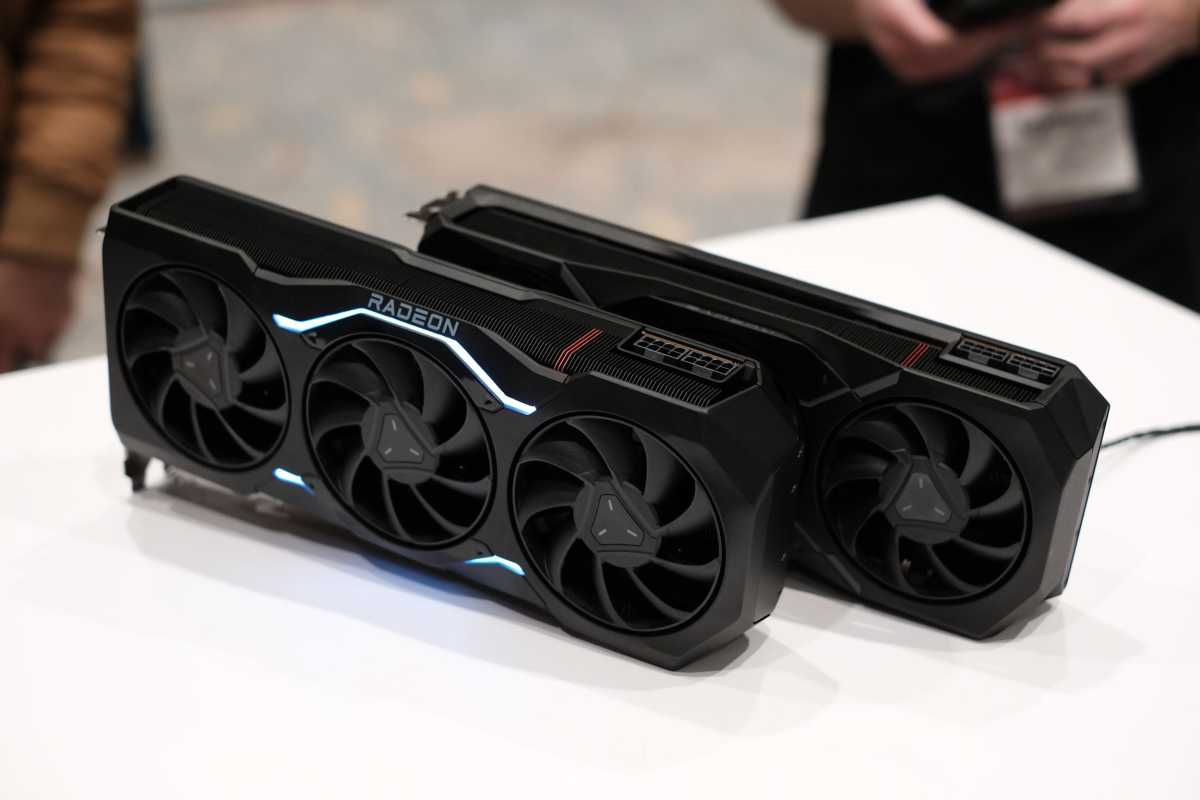
Adam Patrick Murray / IDG
Adam Patrick Murray / IDG
Adam Patrick Murray / IDG
AMD’s duo offers more performance in traditional games and much more memory for hundreds of dollars less than the 4080. Plus, the XTX offers ray tracing performance on par with Nvidia’s best-in-class last generation GPU, the RTX 3090. FSR 2.0 is also quickly being embraced by games that deploy the cutting-edge lighting effects, giving you even more performance. You can also flip on AMD’s universal Radeon Super Resolution upscaling feature in any game that doesn’t support FSR for even higher performance, and it looks great at the 4K resolutions the 7900 series targets. These cards as pricey as hell but deliver outstanding value versus the Team Green competition.
These reference Radeon RX 7900 XTX and XT cards also win in terms of compatibility, thanks to their slim yet attractive 2.5-slot design and dual 8-pin connectors. These fit into virtually any PC, unlike the massive 3- and 4-slot RTX options, which also require the use of finicky new 12VHPWR power cable adapters—though their small size also makes them more audible under load than larger GPUs.
Enough said, right? Not quite.
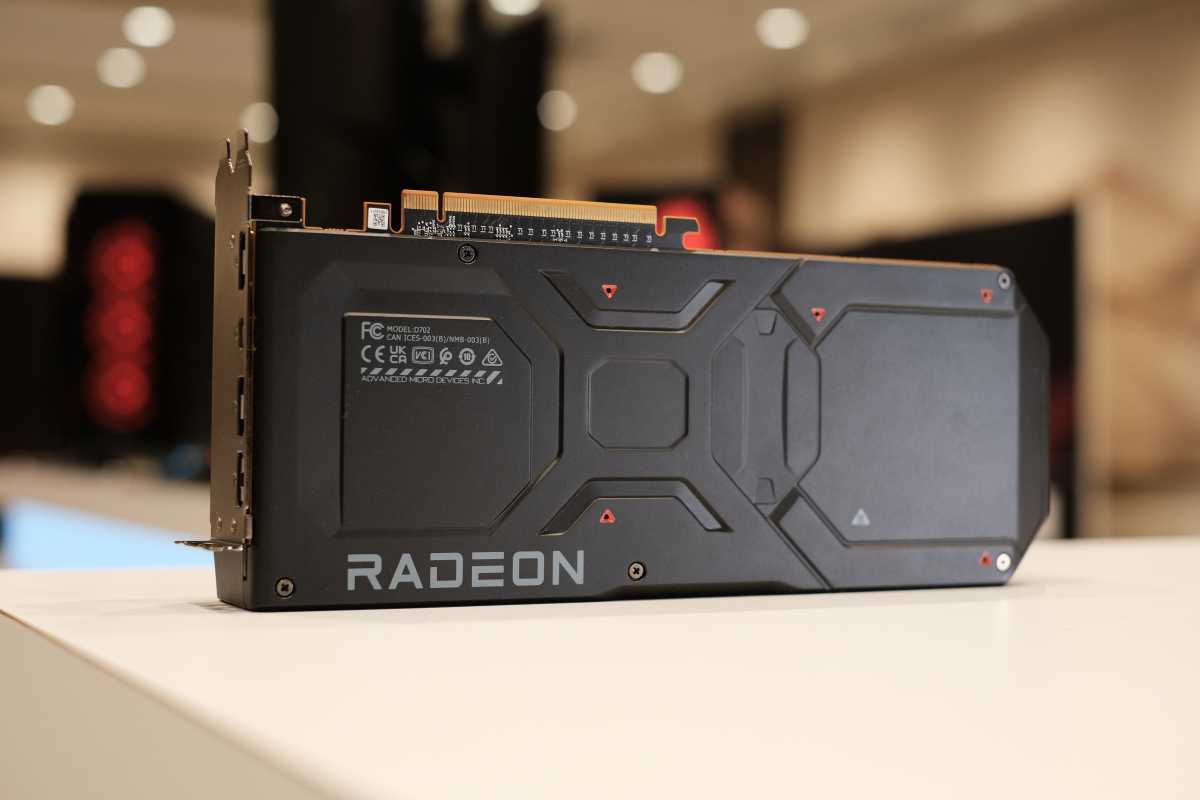
Adam Patrick Murray / IDG
Adam Patrick Murray / IDG
Adam Patrick Murray / IDG
Ray tracing isn’t a weakness for Radeon anymore, but it remains a strength for GeForce. AMD’s second-gen RT implementation in the 7900 series caught up to the RTX 3090’s second-gen prowess, but the RTX 4080 and 4090 pushed the advantage even further, to the point that you don’t even have to use DLSS to hit 60fps in most 4K/Ultra ray-traced games (though you should to push frame rates even higher). That’s amazing, and AMD can’t compare.
AMD also can’t compete against Nvidia’s awesome new DLSS 3 Frame Generation feature, which inserts AI-created frames between every other image for unparalleled visual smoothness and the ability to shatter CPU bottlenecks. Team Red does plan to release FSR 3 with AI-created “Fluid Motion Frames” sometime in 2023, however.
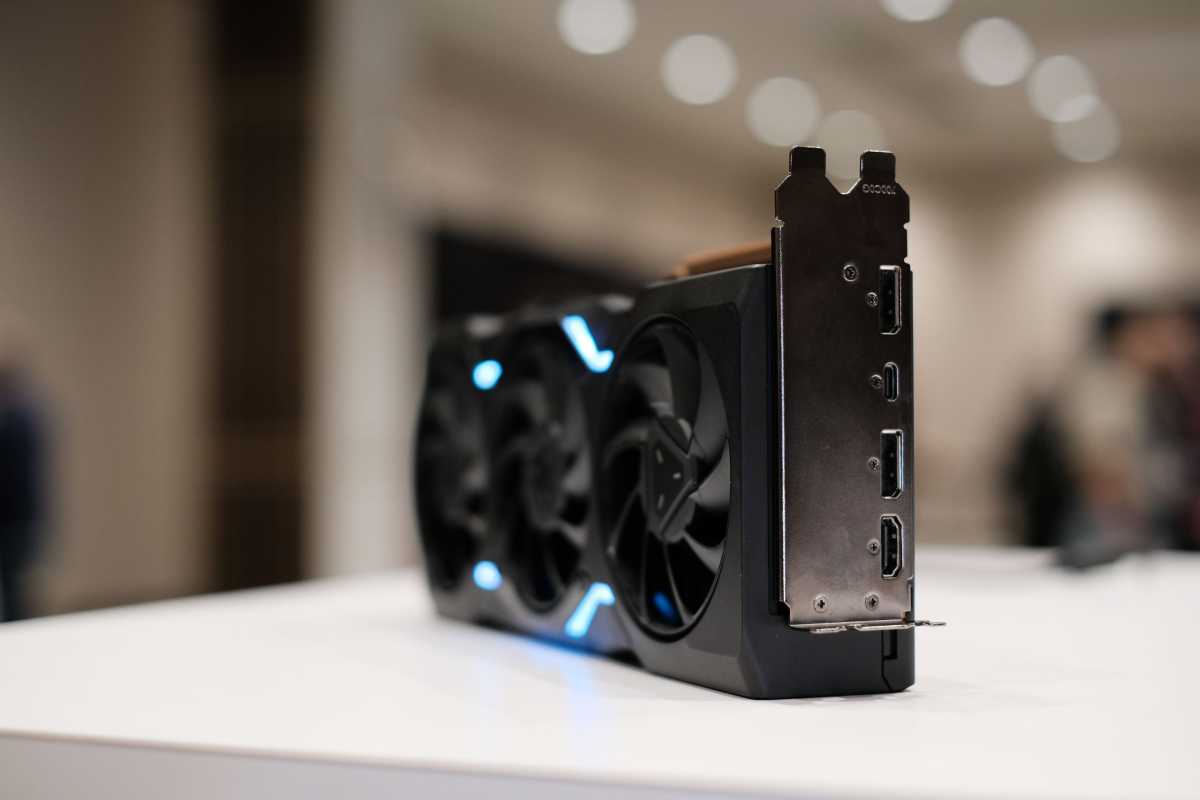
Adam Patrick Murray / IDG
Adam Patrick Murray / IDG
Adam Patrick Murray / IDG
If you care about peak ray tracing performance and want to get in on the AI frame hype train sooner rather than later, you may want to opt for a 4080 instead (though I’d strongly suggest against it after Nvidia jacked its price up by a staggering $500 over the 3080). Or even the GeForce RTX 4090, which boasts those features and ferocious overall performance—it’s the ultimate no-compromises GPU of this generation. That’s especially true for prosumers who can put its dual AV1 encoders and 24GB of ultra-fast GDDR6X VRAM to proper work. You’ll pay dearly for it though: $600 more than the 7900 XTX.
That said, while ray tracing is picking up steam, it’s only a must-use feature in a handful of games, like Cyberpunk 2077, Metro Exodus, Minecraft RTX, and Control. Portal RTX also looks dope as heck (and requires DLSS 3 Frame Gen to run effectively). If it’s more of a nice-to-have feature for your gameplay needs, AMD’s Radeon RX 7900 XTX and XT are much better values.
That that said, we’re currently in a weird time for GPUs, with a glut of last-gen models flooding the market after the pandemic-fueled crypto bubble burst. Most people don’t need a $1,000 graphics card. If you aren’t looking to push frame rates on a high-refresh 4K monitor, last-gen GPUs like the 6900 XT and Nvidia’s RTX 3080 are still solid practical options for 4K/60 and high-refresh 1440p displays, and they can usually be found for around $600 to $750 online. They’re great if you don’t need the latest and greatest. You can save a few hundred more bucks now that the GPU crunch has subsided, and even try to risk holding out for even deeper discounts.
Our guide to the best graphics cards for gaming can help you make the best decision for you.

Adam Patrick Murray / IDG
Adam Patrick Murray / IDG
Adam Patrick Murray / IDG
Bottom line? AMD’s Radeon RX 7900 XT and XTX deliver staggering performance, ample memory, easy compatibility, and software features galore for far less than Nvidia’s latest. They may not unseat the RTX 4090 as the towering raw performance champion, especially if you’re interested in ray tracing, but unlike Nvidia’s price-jacked yet performance-lacking RTX 4080, the Radeon RX 7900 XTX offers stunning value over its predecessor for the same price as before. The 7900 XT, on the other hand, delivers worse value than the flagship and no doubt would’ve been called the 7800 XT (and sold for significantly less) if Nvidia hadn’t already pushed pricing to insane levels with the RTX 4080. Neither the 4080 nor the 7900 XT are particularly appealing at these prices. If you’re already considering spending $899 for the XT, we’d advise saving up some extra pennies and grabbing the $999 XTX instead if you can. It offers a lot more performance in some situations, like Cyberpunk 2077 with ray tracing enabled.
After Nvidia’s next-gen reveal, my colleague Michael Crider said that “Nvidia’s tone-deaf RTX 40-series pricing is a golden opportunity for AMD and Intel.” With the Radeon RX 7900 XTX, at least, AMD is pressing the point. Here’s to a new era of GPU competition after years of stagnation!
Best Prices Today: Radeon RX 7900 XTX
RetailerPrice

Author: Brad Chacos, Executive editor

Brad Chacos spends his days digging through desktop PCs and tweeting too much. He specializes in graphics cards and gaming, but covers everything from security to Windows tips and all manner of PC hardware.
Recent stories by Brad Chacos:
Nvidia GeForce RTX 4080 Super review: The 4K graphics card you wantNew Arc drivers provide huge DX11 performance boost for Intel GPUsAudio Radar gives hearing impaired gamers a fair shot








